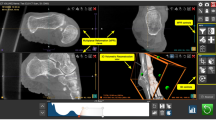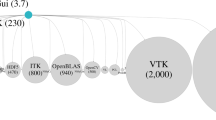Abstract
Software application frameworks provide a modular and reusable context for the development of custom applications, e.g. in the domain of medical image processing and computer assisted surgery (CAS). The utilization of an appropriate software framework can strongly reduce time and costs for software design, implementation, and validation. However, the decision to apply a particular framework poses many risks that can have an impact on the success of the overall software project. There is a need for a software framework evaluation methodology that guides the selection process in an objective, impartial, and repeatable manner. This work defines an evaluation process for the selection of software application frameworks out of a group of candidates that fit best to defined requirements necessary for the development of CAS applications.



Similar content being viewed by others
References
Ammenwerth E, Brender J, Nykanen P, Prokosch H, Rigby M, Talmon J (2004) Visions and strategies to improve evaluation of health information systems: reflections and lessons based on the HIS-EVAL workshop in Innsbruck. Int J Med Inform 73(6):479–491
Ammenwerth E, Graber S, Herrmann G, Burkle T, Konig J (2003) Evaluation of health information systems—problems and challenges. Int J Med Inform 71(2–3):125–135
Bosch J, Molin P, Mattsson M, Bengtsson P (2000) Object-oriented framework-based software development: problems and experiences. ACM Comput Surv 32(1):3
Burgielski Z, Jansen T, von Rymon-Lipinski B, Hanssen N, Keeve E (2002) Julius—a software framework for computer-aided-surgery. Biomed Tech (Berl) 47(Suppl 1 Pt 1):101–103
Comella-Dorda S, Dean JC, Morris EJ, Oberndorf PA (2002) A process for COTS software product evaluation. International conference on COTS-based software systems (ICCBSS), pp 86–96
Fayad M, Schmidt DC (1997) Object-oriented application frameworks. Commun ACM 40(10):32–38
Gary K, Ibanez L, Aylward S, Gobbi D, Blake MB, Cleary K (2006) IGSTK: an open source software toolkit for image-guided surgery. Computer 39(4):46–53
International organisation for standardization (ISO) (1999) ISO/IEC 14598—1:1999 information technology—software product evaluation. ISO/IEC, Geneva, Switzerland
Jian X, Jie T, Mingchang Z, Huiguang H (2005) The design and implementation of a novel platform for medical data visualization. Computer supported cooperative work in design, proceedings of the ninth international conference on computer-supported cooperative work 2:728–733
Konrad-Zuse-Zentrum fur Informationstechnik Berlin (2006) Amira—advanced 3D visualization and volume modeling—user’s guide and reference manual. Berlin, Germany
Korb W, Bohn S, Burgert O et al (2005) Surgical PACS for the digital operating room. Stud Health Technol Inform 119:267–272
MeVis Center For Medical Diagnostic Systems And Visualization in Bremen Germany, MeVisLab—medical image processing and visualization, http://www.mevislab.de, 29.01.2007
Ralph EJ, Brian F (1988) Designing reusable classes. J Object-Oriented Prog 1(2):22–35
Robb RA, Hanson DP (1990) ANALYZE: a software system for biomedical image analysis. Visualization in biomedical computing, proceedings of the first conference on visualization in biomedical computing, Atlanta, GA, pp 507–518
Samset E, Hans A, von Spiczak J, et al (2006) The SIGN: a dynamic and extensible software framework for image-guided therapy. MICCAI workshop on open source and data for medical image computing and computer-assisted intervention, insight-journal
Seifert S, Burgert O, Dillmann R (2002) MEDIFRAME—an extendable software framework for medical applications. Proceedings of surgetica conference, Grenoble, France, pp 224–231
Vasquez A, Bohn S, Gessat M, Burgert O (2007) Evaluation of open source DICOM frameworks. Multi-center information management (MCIM) 2007 workshop, St. Louis
Viceconti M, Astolfi L, Leardini A et al (2004) The multimod application framework. IV ‘04: proceedings of the information visualisation, eighth international conference on information visualisation, pp 15–20
Wolf I, Vetter M, Wegner I et al (2005) The medical imaging interaction toolkit. Med Image Anal 9(6):594–604
Author information
Authors and Affiliations
Corresponding author
Rights and permissions
About this article
Cite this article
Bohn, S., Korb, W. & Burgert, O. A process and criteria for the evaluation of software frameworks in the domain of computer assisted surgery. Med Biol Eng Comput 46, 1209–1217 (2008). https://doi.org/10.1007/s11517-008-0336-9
Received:
Accepted:
Published:
Issue Date:
DOI: https://doi.org/10.1007/s11517-008-0336-9




